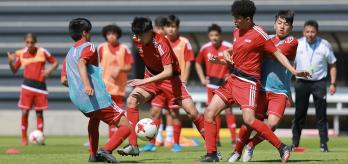“Small-sided” games (training exercises including fewer players than a real game) feature in many training manuals, but how many coaches really know how to make the most of them? Dr Coutinho is a renowned football scientist who specialises in the science of small-sided games. In this Science Explained presentation, he examines how coaches can deliberately design small-sided training games to help them achieve specific technical, physical and tactical objectives.
Introduce the concept of small-sided games. Show how the ability to set the rules of small-sided games has the potential to help coaches to develop their players’ technical, physical and tactical ability.
By carefully adjusting the six key variables at play in small-sided games, coaches can create flexible training exercises that can help their players develop the specific skills they need to improve their performance.
Coaches should consider using small-sided games as a flexible tool for developing technical, physical and tactical skills on the training ground.
Watch video
Read summary
Part 1: An introduction to small-sided games
To begin his presentation, Dr Coutinho gives a summary of the basic concept behind small-sided games. As he explains, whereas technical drills are designed for one specific purpose, small-sided games are more flexible, and can be used to develop technical, physical and tactical skills at the same time. They also give coaches complete freedom to set their own rules, and thus to craft an exercise that encourages players to play, move and think in ways that might not immediately occur to them in a real game.
Part 2: Key variables, part I
In this part of the session, Dr Coutinho begins to address the individual variables coaches can use to tailor small-sided games to the specific needs of their players. This section focuses on how changing the number of players involved in the game, the size of the pitch, and the types of instructions given by coaches can prompt players to change how they approach the exercise, thus fostering specific technical, physical and tactical skills that will fully prepare them for match play.
Part 3: Key variables, part II
In the final section of his presentation, Dr Coutinho turns his attention to three more factors coaches can manipulate when designing small-sided games: the size of the targets (or goals), the rules governing how points are scored, and the length of each game. Tweaking these variables can radically change the way the exercise unfolds, for example by forcing attackers to change the way they dribble or pass the ball, or by making defenders press more aggressively.
Q&A
01:17
We know small-sided games are great for developing technical, physical and tactical ability, but how can practitioners develop all three simultaneously?
03:43
Can small-sided games still be effective for developing one area at the expense of some of the other factors? For example, if a conditioning coach designs an exercise primarily for physical fitness, will it still develop the other areas?
06:09
To me, football is a game of making the right decisions at the right time. How do small-sided games help to develop decision-making?
07:38
Also on decision-making, how can coaches design exercises to nurture decision-making in different age groups?
10:12
It’s clear that player numbers and pitch size have notable effects on performance. Is that effect universal, or is it age-specific?
12:12
I wanted to ask about the negative aspects of small-sided games. What should coaches’ approach be when facilitating these types of tasks, given the potential negative effect of instructions from coaches that you mentioned in your presentation?
14:25
What do modern coaches actually do in small-sided games nowadays?
16:35
You said some rules appear to develop specific behaviours. How can a coach make sure they create a learning environment that caters to all the players’ needs?
18:05
Could you elaborate on the sources of information you can manipulate in a small-sided game, and how they might affect player performance?
21:48
Football is a game of different styles. Should small-sided games align with a team’s playing style? Should coaches design specific positional exercises that align with their playing style?
24:19
Can you provide some basic tips for practitioners about designing and manipulating small-sided games?
 16-9.variant64x64.JPG)







 16-9.variant348x164.JPG)






